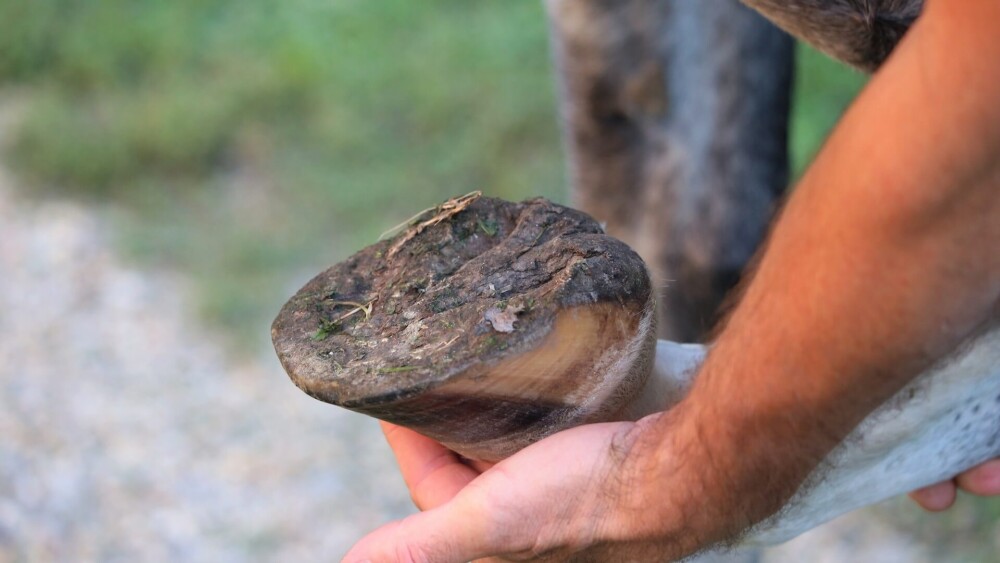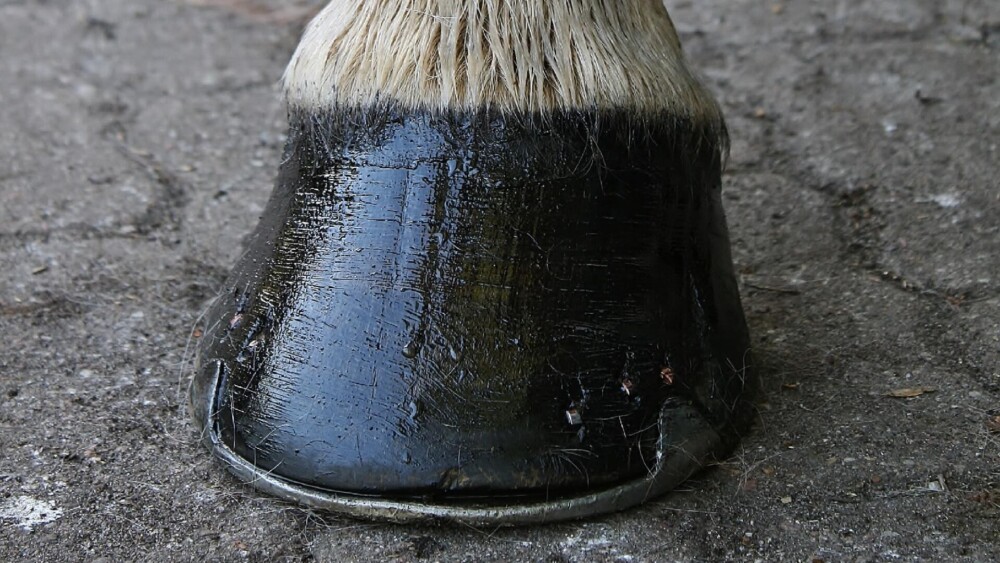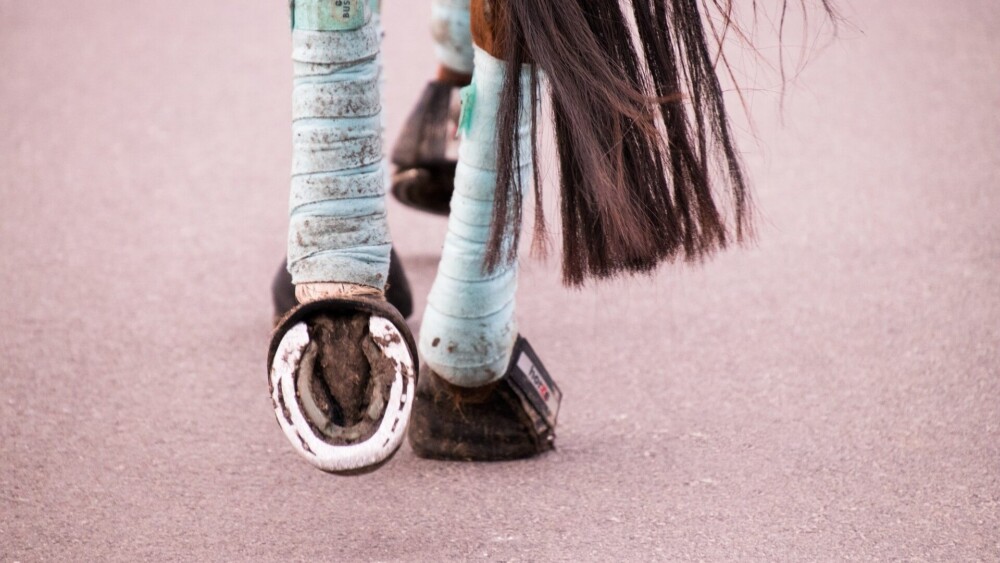One of the most common issues first-time horse owners have is caring for their horse’s hooves. Hoof care can be a real challenge for people who don’t know much about a hoof other than that a flying hoof (aka a kick) is dangerous and results in injuries.
I love watching some of the riding instructors work with young children learning to ride for the first time. One of the first things they teach the kids is to pick up and clean a horse’s hooves. This daily activity is critical when looking after a horse and as preparation when riding a horse.
Picking up and cleaning hooves is where your confidence in your equine partner starts since they are giving you their weapons (a horse kicks, and they won’t give their feet to you willingly if they don’t trust you).
How do you care for a horse’s hooves? Hoof care should be a daily routine that involves picking out your horse’s hooves, cleaning off the mud that may hide injuries and that could cause mud fever, and ensuring your horse’s feet are in good condition.
This is also how you check if hooves are breaking out or damaged. Sometimes, you can address a small breakage in your horse’s nail before it becomes a massive problem with a quarter breaking out.
You can look forward to learning more about trimming your horse’s hooves, balancing their nails, removing dead soles, and correct stretching and flares in our second article on how to trim your horse’s hooves.
Your horse’s hooves are essential to their health and yours. A horse with weak hooves and problem hooves may trip and fall easily or become lame. Know the parts of the horse’s hoof so you can identify any changes or damage quickly.
When I get asked about horse hooves—this happens a lot since my horses are so well trained that they make the cleaning routine look really easy—I like to open my toolbox and show the newbies what products to buy. I also explain what to use these for when it comes to maintaining healthy hooves.
Usually, my explanation goes something like this:
Basic Hoof Maintenance and Products to Condition Hooves
Your horse’s hooves are like your hands. They have nails, they have soft tissue, and they also have a nail bed and cuticle that requires treatment. Different weather conditions and alternating terrain that a horse travels over can affect hooves in unique ways. It’s up to you to keep their hooves healthy so they can remain sound and able to work.
Daily Picking is Essential
Clean your horse’s hooves at least once a day. Plus, you should always clean your horse’s hooves before you get on for a ride. Imagine being asked to run a marathon with a stone in your shoe.
You would have bruises and blisters before you’ve run the first few yards. Now, what if I told you that you had to carry someone who may weigh as much as a quarter of your weight while you run with this stone in your shoe. Would you want to do it?
This is precisely what happens when we ask a horse to work when we haven’t checked their hooves for stones. The frog, specifically the collateral groove, tends to collect rocks, which can bruise your horse’s hooves. This can lead to abscesses forming, lameness, and even cause permanent hoof damage if not treated.
By cleaning out your horse’s hooves daily, picking out stones and loose particles, and checking for injuries, you ensure your horse can work and maintain its health.
Treating Hoof Conditions
The next thing I often help new horse owners with is treating hoof conditions. Some of these are temporary conditions, and if you treat them effectively and timeously, they are a minor concern. Others require more intensive treatment and care to prevent long-term damage.
1. Treating Dry Hooves
Just like people, horses also need special moisturizing agents in their hooves. Dry hooves crack and can become painful. This is usually a winter problem. In summer, when there’s more moisture in the ground or there’s more frequent rain, your horse will have healthier hooves that naturally maintain its moisture levels.
A horse with dry hooves will tend toward hard and brittle hooves, which are more likely to break. Your farrier will also thank you for maintaining healthy and moist hooves, as these are much easier to trim.
I encourage new horse owners to buy a good quality milking cream or even aqueous lotion with additional vitamin E as this is a great way to deal with hard and dry hooves.
While there are some very popular hoof oils on the market, this is not always the best solution. For starters, hoof oil not only “nourishes” the hoof but also seals the hoof, preventing your horse’s hoof from naturally absorbing moisture from the ground.
Hoof oil can also lead to small particles like pebbles, coarse sand, and large stones sticking to your horse’s hoof and embedding into their hoof sole more easily.
2. Protecting Soft Hooves
There are times when your horse’s hooves, specifically their hoof soles, will become soft. This makes their hooves vulnerable to pressure and rough terrain. You may notice your horse doesn’t want to walk on rough ground when its hoof soles are flakey and thin.
Remember that the sole is supposed to be thick to protect the fragile soft laminae of the hoof. If the sole is thin or delicate, it can’t do this effectively.
Too much water in the ground, excessive rain, or a diet rich in sugars can lead to soft hooves. Treat this by spraying your horse’s hooves with a drying agent like wound spray (purple spray), which will also dry the sole.
A great way to prevent moisture-thriving bacterial infections like thrush of the frog is to apply Stockholm tar to the hoof when you see signs of softness and infection.
In some cases, your horse may need corrective shoes to keep its hoof sole off the ground and prevent it from absorbing too much moisture. This is not the first place to start, though, and you can and should start with the easiest solution, which is a drying agent like wound spray or Stockholm tar.
A natural way to harden your horse’s hooves and encourage healthy hoof growth is to feed your horse collagen in the form of gelatine, which is available wholesale from your local baking supplies store. Some horse owners swear by adding crushed eggshells to their horse’s feed to boost their calcium uptake. If you are unsure of these, you can opt for a hoof health supplement for horses.
3. Healing Mud Fever
While not technically a hoof concern, mud fever can create issues for your horse’s lower legs and cause hoof problems if left untreated. In wet weather or if your horse is in mud frequently, you need to watch for mud fever.
If mud fever creates open sores that damage your horse’s coronary band, they can develop a flaw in their hoof that will grow out as a crack or abscess. So ensuring your horse has healthy legs is an investment in healthy hooves.
Be sure to moisturize the coronary band, too, when your horse is standing in wet conditions. Even early morning dew or deep and watery grasses can cause their sensitive coronary band, like their cuticle, to bubble and blister. Adding a moisture restoring lotion or cream to the coronary band can help your horse have healthy hooves that grow naturally.
Maintaining Healthy Hoof Growth
Part of your horse’s hoof maintenance routine should be regular farrier work or trimming to ensure their hooves remain balanced. A horse’s hooves are like the wheels on your truck. If you don’t have them correctly inflated, your wheels will run flat, or you may lose more tread on one tire than the others. A responsible car owner will ensure they regularly check the tire pressure and tread to have a safe and reliable vehicle. A horse owner should do the same.
Be sure to check with your farrier what schedule they recommend for your horse’s trims. Some horses grow their feet faster than others, and the time of year will also determine how fast their hooves will grow and how often they will require trimming.
Don’t base farrier scheduling on your wallet. While you may want to save the few bucks that a farrier will cost you, it is vital to put your horse’s health and welfare first.
Most horses will require a trim and rasp once every 8-10 weeks. Some horses will require corrective work every 4-6 weeks if they have a hoof condition that is causing problems to their movement.
Example 1: Pigeon Toe Hoof Care
My mare, Mihr, has a slight pigeon toe. This means that one of her front legs has a fractional twist in the bones of the hoof, causing her toe to point slightly inward. We can see this when we look at the coronary band, which is not level with the ground as it should be.
There is a slight angle outward, which changes the whole dimension of that particular hoof. While this is considered a minor issue, it does cause the outside wall of her hoof to stretch, placing pressure on the inside wall, which then breaks out.
A horse walks mostly on its hoof nail (the bottom of their hoof wall). If they break parts of the hoof nail off, they can end up with balance issues and strain ligaments.
So, part of Mihr’s farrier schedule is to monitor her hooves daily, check for signs of stretching and breakage, and do corrective rasping every couple of weeks until she is due for a trim again. This helps balance her hoof, keeping it in the optimal position and ensuring that she doesn’t strain her ligaments and tendons.
Mihr has slow-growing hooves, so she is on an 8-10 week schedule, rasping at weeks four and eight if needed. The rate at which she sheds her hoof sole is also a factor in determining how frequently we can trim her hoof nail.
Example 2: Slow Front Feed Solutions
My gelding, McG, has slow front feet. Sometimes, he drags his toes and becomes trippy. He sometimes also trips over his front feet. When he moves, I can hear him forge into his front feet.
This is when the toes of his back hooves knock the bottoms of his front hooves. If left unmanaged, he can cause himself damage and even step on the bulbs of his front hooves, which can cause massive damage.
Our solution there is to dump his back toes. This means that the farrier trims his feet like normal, then she rounds the toe back to his breakline, where his hooves’ waterline starts. This prevents him from stepping on himself without changing the way he moves. It limits his trippiness, and he remains sound, mobile, and without injuries.
Correct farrier work can make a huge difference in your horse’s hoof health, and it can mean the difference between a horse that can work effectively and remain sound and a horse that draws up lame often and develops real problem legs.
To Shoe or Not to Shoe Your Horse
Horseshoes are a somewhat debatable topic in the horse world. Some people believe that horses should be shod when working on hard surfaces, such as tarred roads or over stony ground.
Others see shoes as unnatural and not required. Then there is a small group of horse owners who believe horses should wear shoes, even if there is no reason for the horse being shod.
My general view on shoeing is that there needs to be a reason for your horse to wear shoes. If your horse is prone to breaking its hoof wall or nail, then shoeing your horse may be a good idea.
Should your horse need to get over a hoof-related injury or illness, such as laminitis, your horse would probably need shoes. Horses with naturally thin hoof soles and weak walls may require shoes like some thoroughbreds do for the rest of their lives.
It is also standard practice for many competition riders to shoe their horses, and it’s pretty common to see shoes on competition horses, endurance horses, racehorses, jumpers, and show horses.
Sometimes, this is done for the sake of it being done without considering the horse’s needs. It is a real asset to have a trustworthy farrier who knows what they are doing and won’t simply say your horse needs shoes for the sake of a few extra bucks.
Conclusion
Caring for your horse’s health should include daily hoof care and maintenance. A critical aspect of hoof care is securing the services of a qualified farrier. They can trim your horse’s hooves to ensure healthy hoof growth happens and treat hoof flaws correctly. But what do you do when there’s no farrier around?
There are times when you simply can’t find a farrier. Or, if you are unsure of your farrier, you may wish you knew more about trimming your horse so you could keep an eye on the process and ask better questions. This brings us to the second part of this article, and it’s going to leave you breathless—literally—as we look at the step-by-step basics of how to trim your horse’s feet.
My Favorite Equine Resources For Horses and Donkeys
This list contains affiliate products. Affiliate products do not cost more but helps to support BestFarmAnimals and our goal to provide farm animal owners with accurate and helpful information.
Squeaky Chicken Toy is hilarious to watch and the horses love it! It’s not super tough so keep it away from dogs.
Dewormer with Ivermectin: I use this for my horses and my goats. Duvet makes a great dewormer. I switch between the Ivermectin one and one like this one so the worms don’t get immune to it.
Manna Pro Apple Flavored Nuggets are a delicious smelling treat that my horses go crazy over.
Equinity Amino Acid Supplement for Horses makes a big difference for any horse that’s struggling with arthritis, hoof issues, or just generally. It’s great for older horses who can’t absorb all the nutrients in their food as well!
Manna Pro Weight Accelerator helps older horses gain weight and stay healthier! This was especially helpful when one of my older horses lost weight over the winter and helped her regain her weight over the summer!
Farnam Fly Control goes on the horse or donkey and will keep the flies off your sweet pet. It makes horses way more comfortable and will keep sores from getting infected as well.
Wound Kote protects sores and wounds. It acts as an antiseptic and helps wounds heal faster. It works on both my horses and goats.



